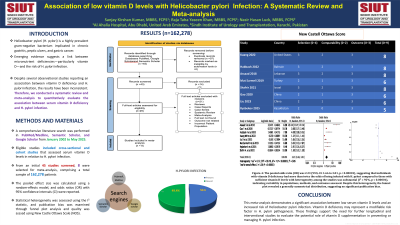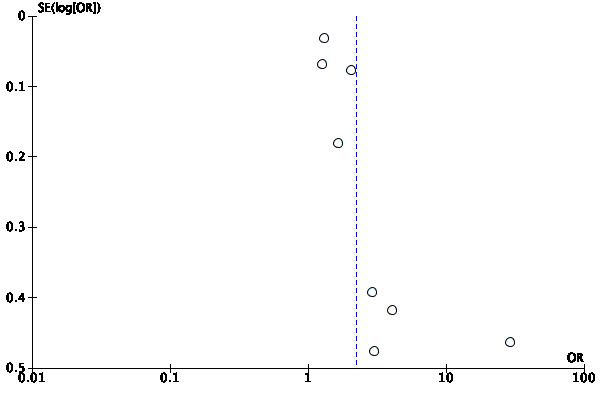Tuesday Poster Session
Category: Stomach and Spleen
P6308 - Association of Low Vitamin D Levels With Helicobacter pylori Infection - A Systematic Review and Meta-Analysis
Tuesday, October 28, 2025
10:30 AM - 4:00 PM PDT
Location: Exhibit Hall

Has Audio
- SK
Sanjay Kirshan Kumar, FCPS
Ahalia Hospital
Abu Dhabi, Abu Dhabi, United Arab Emirates
Presenting Author(s)
Raja Taha Yaseen TY. Khan, MBBS, FCPS, ESEGH1, Sanjay Kirshan Kumar, FCPS2, Salman Ahsam, FCPS, MRCP, ESEGH3, Vijesh Kumar, MBBS1, Wajiha Fasih, MBBS1, Nasir Hassan Luck, FCPS1, Hina Ismail, FCPS4, Abbas Ali Tasneem, MBBS, FCPS1
1Sindh Institute of Urology and Transplantation, Karachi, Sindh, Pakistan; 2Ahalia Hospital, Abu Dhabi, Abu Dhabi, United Arab Emirates; 3Social Security Hospital, Faislabad, Faisalabad, Punjab, Pakistan; 4University Hospital Limerick, Limerick, Limerick, Ireland
Introduction: Vitamin D is not only also crucial to bone metabolism, but it is also important as an immunomodulatory factor, affecting susceptibility to a range of infections. More recently, it has been hypothesized that low serum levels of vitamin D are associated with increased prevalence or persistence of H. pylori infection. However, no comprehensive studies are available up to date. Here, we aim to evaluate the association between low serum vitamin D levels and the risk of H. pylori infection using pooled data from observational studies.
Methods: A comprehensive literature search was conducted using PubMed, Semantic Scholar, and Google Scholar from January 2009 through May 2025. Eligible studies were observational in design (cross-sectional or cohort) and assessed the relationship between vitamin D status and H. pylori infection. Studies reporting odds ratios (ORs), or from which ORs could be calculated, were included. A total of eight studies involving 13,659 participants were selected. Meta-analysis was performed using a random-effects model to calculate the pooled odds ratio (OR) with 95% confidence intervals (CIs). Heterogeneity was assessed using the I² statistic. Publication bias was evaluated via funnel plot analysis.
Results: Eight studies comprising a total of 10,172 patients were included in the meta-analysis. The results demonstrated a significant association between low serum vitamin D levels and H. pylori infection. The pooled odds ratio (OR) was 2.23 (95% CI: 1.66 to 3.01, p < 0.00001), suggesting that individuals with vitamin D deficiency had more than twice the odds of being infected with H. pylori compared to those with sufficient vitamin D levels. Overall, the heterogeneity among the studies was substantial (I² = 92%, p < 0.00001), indicating variability in populations, methods, and outcomes assessed. Despite this heterogeneity, the funnel plot revealed a generally symmetrical distribution, suggesting no significant publication bias.
Discussion: This meta-analysis demonstrates a significant association between low serum vitamin D levels and an increased risk of Helicobacter pylori infection. Vitamin D deficiency may represent a modifiable risk factor in H. pylori pathogenesis. These findings support the need for further longitudinal and interventional studies to evaluate the potential role of vitamin D supplementation in preventing or managing H. pylori infection.


Disclosures:
Raja Taha Yaseen TY. Khan, MBBS, FCPS, ESEGH1, Sanjay Kirshan Kumar, FCPS2, Salman Ahsam, FCPS, MRCP, ESEGH3, Vijesh Kumar, MBBS1, Wajiha Fasih, MBBS1, Nasir Hassan Luck, FCPS1, Hina Ismail, FCPS4, Abbas Ali Tasneem, MBBS, FCPS1. P6308 - Association of Low Vitamin D Levels With <i>Helicobacter pylori</i> Infection - A Systematic Review and Meta-Analysis, ACG 2025 Annual Scientific Meeting Abstracts. Phoenix, AZ: American College of Gastroenterology.
1Sindh Institute of Urology and Transplantation, Karachi, Sindh, Pakistan; 2Ahalia Hospital, Abu Dhabi, Abu Dhabi, United Arab Emirates; 3Social Security Hospital, Faislabad, Faisalabad, Punjab, Pakistan; 4University Hospital Limerick, Limerick, Limerick, Ireland
Introduction: Vitamin D is not only also crucial to bone metabolism, but it is also important as an immunomodulatory factor, affecting susceptibility to a range of infections. More recently, it has been hypothesized that low serum levels of vitamin D are associated with increased prevalence or persistence of H. pylori infection. However, no comprehensive studies are available up to date. Here, we aim to evaluate the association between low serum vitamin D levels and the risk of H. pylori infection using pooled data from observational studies.
Methods: A comprehensive literature search was conducted using PubMed, Semantic Scholar, and Google Scholar from January 2009 through May 2025. Eligible studies were observational in design (cross-sectional or cohort) and assessed the relationship between vitamin D status and H. pylori infection. Studies reporting odds ratios (ORs), or from which ORs could be calculated, were included. A total of eight studies involving 13,659 participants were selected. Meta-analysis was performed using a random-effects model to calculate the pooled odds ratio (OR) with 95% confidence intervals (CIs). Heterogeneity was assessed using the I² statistic. Publication bias was evaluated via funnel plot analysis.
Results: Eight studies comprising a total of 10,172 patients were included in the meta-analysis. The results demonstrated a significant association between low serum vitamin D levels and H. pylori infection. The pooled odds ratio (OR) was 2.23 (95% CI: 1.66 to 3.01, p < 0.00001), suggesting that individuals with vitamin D deficiency had more than twice the odds of being infected with H. pylori compared to those with sufficient vitamin D levels. Overall, the heterogeneity among the studies was substantial (I² = 92%, p < 0.00001), indicating variability in populations, methods, and outcomes assessed. Despite this heterogeneity, the funnel plot revealed a generally symmetrical distribution, suggesting no significant publication bias.
Discussion: This meta-analysis demonstrates a significant association between low serum vitamin D levels and an increased risk of Helicobacter pylori infection. Vitamin D deficiency may represent a modifiable risk factor in H. pylori pathogenesis. These findings support the need for further longitudinal and interventional studies to evaluate the potential role of vitamin D supplementation in preventing or managing H. pylori infection.

Figure: Forest plot showing association of low vitamin D levels with H.Pylori infection

Figure: Funnel plot of the studies included in the meta-analysis
Disclosures:
Raja Taha Yaseen Khan indicated no relevant financial relationships.
Sanjay Kirshan Kumar indicated no relevant financial relationships.
Salman Ahsam indicated no relevant financial relationships.
Vijesh Kumar indicated no relevant financial relationships.
Wajiha Fasih indicated no relevant financial relationships.
Nasir Hassan Luck indicated no relevant financial relationships.
Hina Ismail indicated no relevant financial relationships.
Abbas Ali Tasneem indicated no relevant financial relationships.
Raja Taha Yaseen TY. Khan, MBBS, FCPS, ESEGH1, Sanjay Kirshan Kumar, FCPS2, Salman Ahsam, FCPS, MRCP, ESEGH3, Vijesh Kumar, MBBS1, Wajiha Fasih, MBBS1, Nasir Hassan Luck, FCPS1, Hina Ismail, FCPS4, Abbas Ali Tasneem, MBBS, FCPS1. P6308 - Association of Low Vitamin D Levels With <i>Helicobacter pylori</i> Infection - A Systematic Review and Meta-Analysis, ACG 2025 Annual Scientific Meeting Abstracts. Phoenix, AZ: American College of Gastroenterology.
